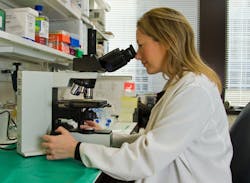Evolutionary forces at play in the aging of the blood system could provide early warning for blood malignancies
As people age, mutations can build up in blood stem cells and their clones in a process known as age-related clonal hematopoiesis, or ARCH. ARCH can be a risk factor for acute myeloid leukemia (AML), a form of blood cancer. The study was reported by the Ontario Institute for Cancer Research (OICR).
New research provides insight into why some with ARCH go on to develop AML and others don’t. These findings, recently published in Nature Communications, have the potential to significantly advance the early detection and treatment of AML by identifying those at high risk of the disease so they can be monitored more closely.
The study, co-led by Dr. Philip Awadalla, Senior Principal Investigator and Director, Computational Biology at OICR and Dr. Quaid Morris, Member, Computational and Systems Biology, Memorial Sloan Kettering Cancer Center (MSK) and OICR Associate, shows how the interplay of positive, neutral and negative evolutionary selection acting on mutations in aging blood stem cells can lead to AML in some individuals with ARCH.
They did so by illustrating how negative selection, or ‘purifying selection’, present in individuals who did not go on to develop a malignancy, prevents disease-related cells from coming to dominate the cell population. These discoveries allow for the differentiation between those with ARCH who are at increased risk of developing AML and those who are not.
“We have shown that the constellation of evolutionary forces at play within hematopoietic stem cells can be a robust indicator of those who are at increased risk of blood cancers such as AML,” says Awadalla. “Being able to accurately classify patients based on risk can allow for more frequent and intensive screening for those with ARCH mutations with a concerning evolutionary signature.”
The researchers were able to show that these alternative evolutionary models were predictive of AML risk over time. Similarly, these tools were able to identify genes where mutations that are damaging to stem cells can accumulate.
“In the future, we can anticipate screening blood samples for early detection of disease and blood cancers. With these tools we can more proactively monitor people’s health. Early detection of cancer is critical with respect to prevention and effectiveness of treatment,” adds Awadalla.
